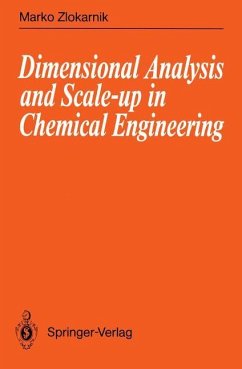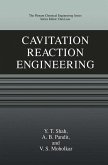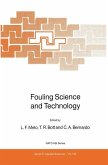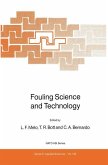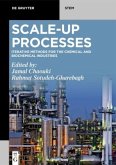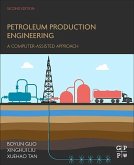Marko Zlokarnik
Dimensional Analysis and Scale-up in Chemical Engineering
Marko Zlokarnik
Dimensional Analysis and Scale-up in Chemical Engineering
- Broschiertes Buch
- Merkliste
- Auf die Merkliste
- Bewerten Bewerten
- Teilen
- Produkt teilen
- Produkterinnerung
- Produkterinnerung
Dieses Lehrbuch führt Studenten verständlich in die Dimensionsanalyse und die Theorie der Ähnlichkeit zur Übertragung von Technikums-Prozessen auf Produktionsanlagen ein. Dem Verfahrenstechniker hilft es bei Konstruktionsproblemen, die mit numerischen Methoden nicht mehr lösbar sind.
Andere Kunden interessierten sich auch für
![Cavitation Reaction Engineering Cavitation Reaction Engineering]() Y. T. ShahCavitation Reaction Engineering249,99 €
Y. T. ShahCavitation Reaction Engineering249,99 €![Fouling Science and Technology Fouling Science and Technology]() L. Melo / T.R. Bott / Carlos A. Bernardo (Hgg.)Fouling Science and Technology416,99 €
L. Melo / T.R. Bott / Carlos A. Bernardo (Hgg.)Fouling Science and Technology416,99 €![Fouling Science and Technology Fouling Science and Technology]() Fouling Science and Technology415,99 €
Fouling Science and Technology415,99 €![Scale-Up Processes Scale-Up Processes]() Scale-Up Processes119,95 €
Scale-Up Processes119,95 €![Electrochemical Engineering Electrochemical Engineering]() Hartmut WendtElectrochemical Engineering202,99 €
Hartmut WendtElectrochemical Engineering202,99 €![Electrochemical Engineering Electrochemical Engineering]() Hartmut WendtElectrochemical Engineering132,99 €
Hartmut WendtElectrochemical Engineering132,99 €![Petroleum Production Engineering Petroleum Production Engineering]() Guo, PhD, BoyunPetroleum Production Engineering160,50 €
Guo, PhD, BoyunPetroleum Production Engineering160,50 €-
-
-
Dieses Lehrbuch führt Studenten verständlich in die Dimensionsanalyse und die Theorie der Ähnlichkeit zur Übertragung von Technikums-Prozessen auf Produktionsanlagen ein. Dem Verfahrenstechniker hilft es bei Konstruktionsproblemen, die mit numerischen Methoden nicht mehr lösbar sind.
Hinweis: Dieser Artikel kann nur an eine deutsche Lieferadresse ausgeliefert werden.
Hinweis: Dieser Artikel kann nur an eine deutsche Lieferadresse ausgeliefert werden.
Produktdetails
- Produktdetails
- Verlag: Springer / Springer Berlin Heidelberg / Springer, Berlin
- Artikelnr. des Verlages: 978-3-540-54102-8
- 1991.
- Seitenzahl: 192
- Erscheinungstermin: 28. Oktober 1991
- Englisch
- Abmessung: 235mm x 155mm x 11mm
- Gewicht: 300g
- ISBN-13: 9783540541028
- ISBN-10: 3540541020
- Artikelnr.: 29013452
- Verlag: Springer / Springer Berlin Heidelberg / Springer, Berlin
- Artikelnr. des Verlages: 978-3-540-54102-8
- 1991.
- Seitenzahl: 192
- Erscheinungstermin: 28. Oktober 1991
- Englisch
- Abmessung: 235mm x 155mm x 11mm
- Gewicht: 300g
- ISBN-13: 9783540541028
- ISBN-10: 3540541020
- Artikelnr.: 29013452
1 Dimensional Analysis.- 1.1 A Brief Historical Survey.- 1.2 Introduction to Dimensional Analysis.- 1.3 Fundamentals of Dimensional Analysis.- 2 Description of a Physical Process with a full Set of Dimensionless Numbers.- 2.1 The Relevance List for a Problem.- 2.2 Determination of a Complete Set of Dimensionless Numbers.- 2.3 The ? Relationship.- 2.4 Reduction of the Size of the Matrix.- 2.5 Change of Dimensional Systems.- 3 Similarity and Scale-up.- 3.1 Basic Principles of Scale-up.- 3.2 Experimental Methods for Scale-up.- 3.3 Scale-up under Conditions of Partial Similarity.- 4 Treatment of Variable Physical Properties by Dimensional Analysis.- 4.1 Dimensionless Representation of the Material Function.- 4.2 The ? set for Variable Physical Properties.- 4.3 Treatment of non-Newtonian Liquids by Dimensional Analysis.- 4.4 Treatment of Viscoelastic Liquids by Dimensional Analysis.- Examples of Practical Application.- A Examples from the Field of Mechanical Unit Operations.- Introductory remarks.- Example A 1:.- Power consumption and mixing time for the homogenization of liquid mixtures. Design principles for stirrers and the determination of optimum conditions (minimum mixing work P?).- Example A 2:.- Power consumption in the case of gas/liquid contacting. Design principles for stirrers and model experiments for scale-up.- Example A 3:.- Power consumption and gas throughput in self-aspirating hollow stirrers. Optimum conditions for P/q = min and an answer to the question whether this type of stirrer is suitable for technical applications.- Example A 4:.- Mixing of solids in drums with axially operating paddle mixer.- Example A 5:.- Gas hold-up in bubble columns and its dependenceon geometric, physical and process-related parameters.- Example A 6:.- Description of theflotation process with the aid of two intermediate quantities.- Example A 7:.- Preparation of design and scale-up data for mechanical foam breakers without knowledge of the physical properties of the foam.- Example A 8:.- Description of the temporal course of spin drying in centrifugal filters.- Example A 9:.- Description of particle separation by means of inertial forces.- Example A 10:.- Conveying characteristics of single-screw machines for Newtonian and non-Newtonian liquids. Optimum conditions (P/q = min) and scale-up.- B Examples from the Field of Thermal Unit Operations-Heat and Mass Transfer.- Introductory Remarks.- Example B1:.- Steady-state heat transfer in the mixing vessel at cooling and the optimum conditions for maximum removal of the heat of reaction.- Example B2:.- Steady-state heat transfer in bubble columns.- Example B3:.- Time course of temperature equalization in a liquid with temperature-dependent viscosity in the case of free convection.- Example B4:.- Mass transfer in the gas/liquid system in mixing vessels (bulk aeration) and in biological waste water treatment pools (surface aeration).- Example B5:.- Design and scale-up of injectors as gas distributors in bubble columns.- Example B6:.- Scale-up problems relating to continuous, carrier-free electrophoresis.- C Examples from the Field of Chemical Reaction Engineering.- Introductory remarks:.- Example C1:.- Continuous chemical reaction processes in a tubular reactor.- 1. Homogeneous irreversible reactions of the 1st order.- 2. Heterogeneous catalytic reactions of the 1st order.- Example C2:.- Influence of back-mixing (macromixing) on the degree of conversion in continuous chemical reaction operation.- Example C 3:.- Influence of micro-mixing on selectivity in a continuous chemical reaction process.- Example C4:.- Mass transfer limitation of the reaction rate of fast chemical reactions in the heterogeneous material system gas/liquid.- Important, Named Dimensionless Numbers.- A Mechanical Unit Operations.- B Thermal Unit Operations (Heat Transfer).- C Thermal Unit Operations (Mass Transfer).- D Chemical Reaction Engineering.- References.- A Single Topics.- B Books and General Treatises.- C Examples of Application.
1 Dimensional Analysis.- 1.1 A Brief Historical Survey.- 1.2 Introduction to Dimensional Analysis.- 1.3 Fundamentals of Dimensional Analysis.- 2 Description of a Physical Process with a full Set of Dimensionless Numbers.- 2.1 The Relevance List for a Problem.- 2.2 Determination of a Complete Set of Dimensionless Numbers.- 2.3 The ? Relationship.- 2.4 Reduction of the Size of the Matrix.- 2.5 Change of Dimensional Systems.- 3 Similarity and Scale-up.- 3.1 Basic Principles of Scale-up.- 3.2 Experimental Methods for Scale-up.- 3.3 Scale-up under Conditions of Partial Similarity.- 4 Treatment of Variable Physical Properties by Dimensional Analysis.- 4.1 Dimensionless Representation of the Material Function.- 4.2 The ? set for Variable Physical Properties.- 4.3 Treatment of non-Newtonian Liquids by Dimensional Analysis.- 4.4 Treatment of Viscoelastic Liquids by Dimensional Analysis.- Examples of Practical Application.- A Examples from the Field of Mechanical Unit Operations.- Introductory remarks.- Example A 1:.- Power consumption and mixing time for the homogenization of liquid mixtures. Design principles for stirrers and the determination of optimum conditions (minimum mixing work P?).- Example A 2:.- Power consumption in the case of gas/liquid contacting. Design principles for stirrers and model experiments for scale-up.- Example A 3:.- Power consumption and gas throughput in self-aspirating hollow stirrers. Optimum conditions for P/q = min and an answer to the question whether this type of stirrer is suitable for technical applications.- Example A 4:.- Mixing of solids in drums with axially operating paddle mixer.- Example A 5:.- Gas hold-up in bubble columns and its dependenceon geometric, physical and process-related parameters.- Example A 6:.- Description of theflotation process with the aid of two intermediate quantities.- Example A 7:.- Preparation of design and scale-up data for mechanical foam breakers without knowledge of the physical properties of the foam.- Example A 8:.- Description of the temporal course of spin drying in centrifugal filters.- Example A 9:.- Description of particle separation by means of inertial forces.- Example A 10:.- Conveying characteristics of single-screw machines for Newtonian and non-Newtonian liquids. Optimum conditions (P/q = min) and scale-up.- B Examples from the Field of Thermal Unit Operations-Heat and Mass Transfer.- Introductory Remarks.- Example B1:.- Steady-state heat transfer in the mixing vessel at cooling and the optimum conditions for maximum removal of the heat of reaction.- Example B2:.- Steady-state heat transfer in bubble columns.- Example B3:.- Time course of temperature equalization in a liquid with temperature-dependent viscosity in the case of free convection.- Example B4:.- Mass transfer in the gas/liquid system in mixing vessels (bulk aeration) and in biological waste water treatment pools (surface aeration).- Example B5:.- Design and scale-up of injectors as gas distributors in bubble columns.- Example B6:.- Scale-up problems relating to continuous, carrier-free electrophoresis.- C Examples from the Field of Chemical Reaction Engineering.- Introductory remarks:.- Example C1:.- Continuous chemical reaction processes in a tubular reactor.- 1. Homogeneous irreversible reactions of the 1st order.- 2. Heterogeneous catalytic reactions of the 1st order.- Example C2:.- Influence of back-mixing (macromixing) on the degree of conversion in continuous chemical reaction operation.- Example C 3:.- Influence of micro-mixing on selectivity in a continuous chemical reaction process.- Example C4:.- Mass transfer limitation of the reaction rate of fast chemical reactions in the heterogeneous material system gas/liquid.- Important, Named Dimensionless Numbers.- A Mechanical Unit Operations.- B Thermal Unit Operations (Heat Transfer).- C Thermal Unit Operations (Mass Transfer).- D Chemical Reaction Engineering.- References.- A Single Topics.- B Books and General Treatises.- C Examples of Application.
